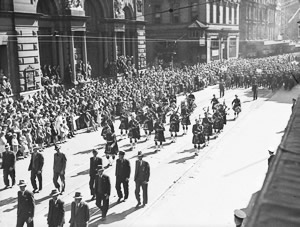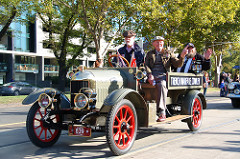Drama ES1
Overview

Anzac Day March, Sydney, 1944
©Public domain (State Library of NSW)
Students take on the role of characters to enact images from the book My Grandad Marches on Anzac Day by Catriona Hoy and Benjamin Johnson.
Teaching and learning activities

Anzac Day parade, Melbourne, 2013
How do people interact with each other in an Anzac Day march?
-
Choose an image from the book My Grandad Marches on Anzac Day by Catriona Hoy and Benjamin Johnson and ask students to imagine what is happening.
-
Consider what the characters are doing and where they are on Anzac Day.
-
Create freeze frames from the image with emphasis on the facial expressions.
-
Explore different ways the characters interact in the scene.
-
Bring the image to life with students enacting characters on the page.
-
Add music and movement to the enactment.
Resources:
My Grandad Marches on Anzac Day by Catriona Hoy and Benjamin Johnson (illustrations)
YouTube videos of Anzac Day marches, for example, Australian Air League – Anzac Day 2015
Learning concepts
These additional questions can be used for discussion or further investigations.
Caring
What emotions do spectators and participants feel at an Anzac Day march? How do they support others?
Community
How does the community come together in an Anzac Day march? What conversations would people be having with each other?
Syllabus links
Students engage in roles through imaginative play and dramatic situations. They use movement, spaces and objects to dramatise personal experiences. They respond to different forms of dramatic experiences.
DRAES1.1 Uses imagination and the elements of drama in imaginative play and dramatic situations.
DRAES1.3 Dramatises personal experiences using movement, space and objects.
DRAES1.4 Responds to dramatic experiences.